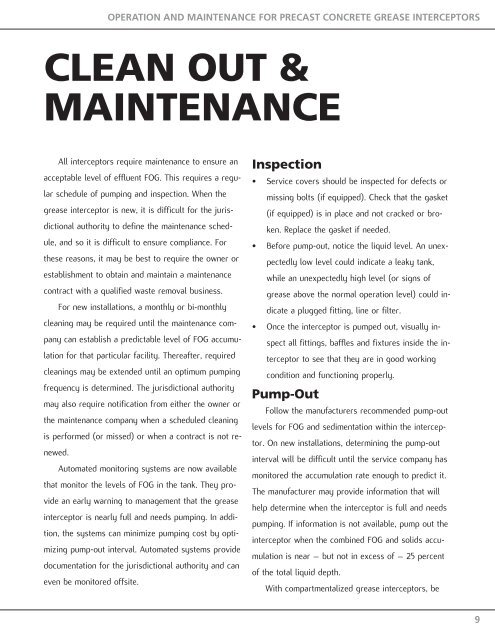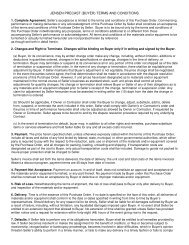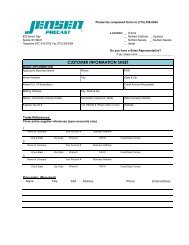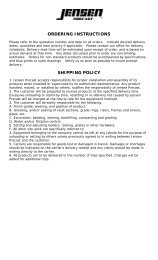Grease Interceptor O & M Manual (PDF) - National Precast Concrete ...
Grease Interceptor O & M Manual (PDF) - National Precast Concrete ...
Grease Interceptor O & M Manual (PDF) - National Precast Concrete ...
Create successful ePaper yourself
Turn your PDF publications into a flip-book with our unique Google optimized e-Paper software.
OPERATION AND MAINTENANCE FOR PRECAST CONCRETE GREASE INTERCEPTORS<br />
CLEAN OUT &<br />
MAINTENANCE<br />
All interceptors require maintenance to ensure an<br />
acceptable level of effluent FOG. This requires a regular<br />
schedule of pumping and inspection. When the<br />
grease interceptor is new, it is difficult for the jurisdictional<br />
authority to define the maintenance schedule,<br />
and so it is difficult to ensure compliance. For<br />
these reasons, it may be best to require the owner or<br />
establishment to obtain and maintain a maintenance<br />
contract with a qualified waste removal business.<br />
For new installations, a monthly or bi-monthly<br />
cleaning may be required until the maintenance company<br />
can establish a predictable level of FOG accumulation<br />
for that particular facility. Thereafter, required<br />
cleanings may be extended until an optimum pumping<br />
frequency is determined. The jurisdictional authority<br />
may also require notification from either the owner or<br />
the maintenance company when a scheduled cleaning<br />
is performed (or missed) or when a contract is not renewed.<br />
Automated monitoring systems are now available<br />
that monitor the levels of FOG in the tank. They provide<br />
an early warning to management that the grease<br />
interceptor is nearly full and needs pumping. In addition,<br />
the systems can minimize pumping cost by optimizing<br />
pump-out interval. Automated systems provide<br />
documentation for the jurisdictional authority and can<br />
even be monitored offsite.<br />
Inspection<br />
• Service covers should be inspected for defects or<br />
missing bolts (if equipped). Check that the gasket<br />
(if equipped) is in place and not cracked or broken.<br />
Replace the gasket if needed.<br />
• Before pump-out, notice the liquid level. An unexpectedly<br />
low level could indicate a leaky tank,<br />
while an unexpectedly high level (or signs of<br />
grease above the normal operation level) could indicate<br />
a plugged fitting, line or filter.<br />
• Once the interceptor is pumped out, visually inspect<br />
all fittings, baffles and fixtures inside the interceptor<br />
to see that they are in good working<br />
condition and functioning properly.<br />
Pump-Out<br />
Follow the manufacturers recommended pump-out<br />
levels for FOG and sedimentation within the interceptor.<br />
On new installations, determining the pump-out<br />
interval will be difficult until the service company has<br />
monitored the accumulation rate enough to predict it.<br />
The manufacturer may provide information that will<br />
help determine when the interceptor is full and needs<br />
pumping. If information is not available, pump out the<br />
interceptor when the combined FOG and solids accumulation<br />
is near – but not in excess of – 25 percent<br />
of the total liquid depth.<br />
With compartmentalized grease interceptors, be<br />
9





